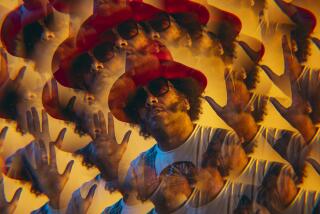Amnesty’s New Cause
In an episode this season of “ER,” actor Noah Wyle, who plays the young, honorable Dr. Carter, walked in front of the cameras wearing a gray T-shirt with the Amnesty International logo on the front. There were no lines in the script about either Carter’s T-shirt or the 40-year-old human rights organization, but the message to NBC viewers was clear: Guys like Carter--cool guys--dig Amnesty International.
But the path of that message from Amnesty International to the set of an incredibly popular, award-winning drama is less clear.
Through his publicist, Wyle said that although he thinks Amnesty is “terrific,” the shirt was happenstance. It was just one of several he could have selected that day from the costumers, including one bearing a Nike logo. That’s true, but there was a backup plan to ensure Amnesty’s “prime-time, pro bono, product placement.”
Had Wyle chosen the Nike shirt, another cast member or an extra would have been given the gray T-shirt.
“We sent these T-shirts around to costumers ... and a lot of them were so happy to get Amnesty some exposure,” said Julie Weinhouse, owner of Hero Product Placement, an advertising firm whose paying clients include Lego, Hawaiian Punch and Radisson. “The costumers said they’d try to get it on somebody. But celebrities don’t want to officially endorse something, so it’s an implied endorsement.”
A new day has dawned for Amnesty International, which is determined to replenish its aging member base with a new generation of activists. Suddenly, it is not just a gadfly to despots and a hero to thousands of oppressed individuals. Amnesty International is employing sophisticated media strategies that dwarf its previous attempts to keep up with the times. The new strategies include surgical prime-time placement, a post-Academy Awards bash and a film festival in West Hollywood.
“We need a revolution from people in a business that has clout,” said Bonnie Abaunza, who was hired away from a small film company last spring to start Amnesty International’s national office of artist relations. “We are asking them to champion a particular prisoner of conscience. We’re going out actively into the community and asking them to help us take this to a whole new level, including an advisory board of artists who will help shape our strategies.”
Abaunza came on board in May and asked Weinhouse to start working on prime-time series that same month. She also made the rounds of producers and actors in hopes of linking Amnesty with future projects. Simply put, Abaunza knew that prime-time subliminal programming would not be enough. She needed to penetrate Hollywood. Then the terrorist attacks of Sept. 11 occurred, and the strategy to tie Amnesty’s logo and literature to several movie premieres was postponed for nearly three months. When she returned to the drawing board, the Christmas movie premieres were already set in stone, and Abaunza revamped the campaign to fit in with Hollywood’s next news cycle--the film festivals and award show season of late winter.
“Sept. 11 reinforced for every American that the violation of people’s human rights have a profound and direct impact on our own lives, our security, our economic lives, our public health,” said Amnesty International USA’s executive director, William Schulz. “Who is in a better position to reach both mainstream Americans and different demographic segments of the population with the message that human rights matter, and that our very lives are at stake if we deny people’s human rights around the world? Who is in a better position than the artistic community? Nobody.”
Amnesty faces different kinds of challenges than the causes that Hollywood has embraced in the past. Typically, the media elite rally around causes when one of their own is affected: Paul Glaser championed AIDS awareness after his wife died from the disease. Katie Couric became a spokeswoman for colorectal cancer after she lost her husband to it. Muhammad Ali and Michael J. Fox have pushed for research into Parkinson’s disease.
But few members of the entertainment industry have been held in foreign jails, banished to life in exile or imprisoned without trials. Amnesty must get image makers emotionally invested in the plight of an unidentifiable population of victims. In a sense, then, Amnesty has to make stars of its survivors, make them knowable to an industry willing to adopt them.
A good example is Jose Ramos-Horta, the Nobel Peace Prize-winning East Timor refugee, who thanks Abaunza for bicoastal talent representation and a book deal. The 52-year-old Ramos-Horta, who has returned to his homeland to help rebuild the country, is writing a book about his experience. Weeks after Abaunza came on board, she put him in touch with a few talent agencies, including William Morris, which ultimately signed Ramos-Horta with Suzanne Gluck in New York and Alicia Gordon in Los Angeles.
“For him, it’s a real channel for getting out his message of hope for people oppressed everywhere,” Ramos-Horta’s spokeswoman, Mary Wald, said by phone from outside New York City. “Bonnie also hooked us up with HarperCollins, one of the four big publishers. We’re looking into film rights too. Martin Sheen and Emma Thompson have been involved in a project about him before, and he spoke with Andy Garcia about possibly playing him.... This is what Bonnie’s getting started here--introducing Jose and East Timor to Hollywood. We’re anticipating that great things will come out of it. It’s been a really interesting networking thing, where a lot of us have hooked together our East Timor contacts.”
Abaunza’s campaign, Artists for Amnesty, which will be launched in the next few weeks, is a rebranding of the organization in response to a member survey commissioned three years ago. That research revealed that Amnesty’s typical member is much like “ER’s” Dr. Carter, except much older--a big problem for a member-supported organization.
“We need to get our message out to people who are not doctoral students,” said Dennis R. Palmieri, spokesman for Amnesty International USA. “This outreach is about visibility--about casting that net wider.”
For Amnesty folks, that means hanging out with popular young Hollywood stars whose very association with the group will spur high school and college-age students to participate in Amnesty events and send in donations. (Eighty-five percent of Amnesty’s budget comes from individual donations of about $50 each.)
Amnesty’s membership woes are well known among heads of liberal and progressive nonprofits, said Morris Dees, co-founder of the Southern Poverty Law Center, a 500,000-member civil rights organization that opened its doors in Montgomery, Ala., in 1971. According to Dees, the typical center member is now almost 60.
“It’s been a constant for the past 15 years to try to enlarge the universe you can go to to try to enlist new supporters,” he said. “There are a few ways that we bring in new people. The biggest way we try is the Internet.... Unfortunately, the average Internet gift tends to be small.”
But Amnesty executives say that they’re more than amenable to an influx of modest donations. In fact, one of their new goals is to attract young people through the Internet and through independent film projects that deal with themes of human rights.
Amnesty International began in 1961 as a modest letter-writing campaign to free two Portuguese students who were wrongly imprisoned. By 1977 it had won the Nobel Peace Prize, and by the mid-’80s, students on college campuses across the country were writing letters in protest of South Africa’s apartheid policies and the U.S. support of freedom fighters in Central America. Amnesty had tapped into star power, with Susan Sarandon, Sting and Bruce Springsteen anchoring rallies and outdoor concerts. In the 1990s, Amnesty embraced the power of e-mail as a way to blitz human-rights violators, from world leaders to local officials.
But by the late 1990s, when data from the member-profile survey came back, Amnesty executives began to wonder if its logo of a lone candle wrapped in wire could inspire a new crop of activists. There were 1 million members worldwide and a full-time office at the U.N., but it seemed the membership was composed increasingly of the Kent State generation, people whose children seemed to care more about Napster than the plight of women and children smothered by the Taliban.
“We’re about building a culture of human rights,” spokesman Palmieri said. “And in order for us to do that, we have to be at the epicenter of pop culture.”
In February, the Artists for Amnesty campaign will bring to West Hollywood a version of the film festival that is already popular in Seattle.
“These buzz cultivational events work both ways. The studios get a lot out of it. We have definitely enjoyed strong support from the artistic community for a long time,” Palmieri said. “What we have not had until now is a structured program to sustain their involvement and meet their needs. In the past, we’ve done big promotional concerts and screenings to reach out to our celebrity supporters to come out and support our work.... It’s been more ad hoc in the past. It’s always important to be reaching out to a new generation of artists and a new generation of members. We have to roll with the times.”
Abaunza is also putting together Amnesty’s first post-Oscar party. Held in conjunction with the city of West Hollywood, the party faces stiff competition from long traditions such as the Governors Ball; the Vanity Fair Oscar party at Morton’s; the Spago party (a tradition initiated by literary agent Irving “Swifty” Lazar); Elton John’s party; and Miramax’s party at the Beverly Wilshire Hotel with host Harvey Weinstein.
“The focus of the guest list is socially conscious, interested, hip people,” said Fran Solomon, deputy to West Hollywood Mayor John Heilman. The venue has not been locked down, although Solomon and Abaunza have been meeting with the manager of a popular restaurant-nightclub on Sunset Boulevard to work out a donated space for the evening.
The Amnesty party theme will be “Young Hollywood,” and the motive is member recruitment through glitzy press.
There’s no telling if these strategies--the prime-time product placement, the film festival or the Oscar party--will have a dramatic effect on Amnesty’s membership, but Amnesty is aware it needs to gain ground in a city where almost every A-list actor is already associated, if only for public relations reasons, with a noble cause.
The group will look for an edge Hollywood-style, with good-looking people doing good deeds before well-positioned cameras.
More to Read
Sign up for Essential California
The most important California stories and recommendations in your inbox every morning.
You may occasionally receive promotional content from the Los Angeles Times.










